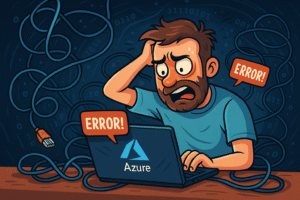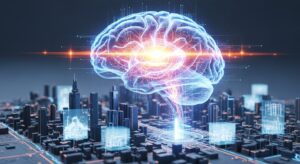The AI Revolution in Capability Modeling: Unlocking Hidden Business Gaps and Opportunities
Imagine your enterprise strategy workshops are no longer solely reliant on subjective input or the loudest voice in the room. What if, instead, an intelligent system could objectively spotlight the weak links, flag emerging risks, and unveil hidden gems within your business model, all backed by comprehensive data analysis? For years, enterprise strategists and business analysts have meticulously crafted capability maps—visual blueprints of “what a business does” rather than “how it does it.” These maps are crucial for aligning strategic intent with operational execution, guiding investment, and identifying areas for improvement.
Yet, the traditional approach to business capability modeling often faces a significant challenge: it can be a static snapshot, prone to biases, and labor-intensive to keep current. Gathering insights typically involves countless interviews, workshops, and manual data collation, which, while valuable, can lag behind the rapid pace of market change. In a world where agility is paramount, relying on an outdated map is akin to navigating with a paper atlas in the age of real-time GPS.
This is where Artificial Intelligence steps in, ushering in a new era: Capability Modeling 2.0. This isn’t just about digitizing existing maps; it’s about transforming them into living, data-driven instruments that continuously inform and optimize strategic decisions. By the end of this article, enterprise architects, strategy executives, and business analysts will gain a profound understanding of how AI can elevate their strategic planning, moving beyond intuition to evidence-based insights that drive tangible business outcomes. We’ll explore how AI can turn what was once a workshop-based artifact into a dynamic tool for navigating the complexities of the modern enterprise, helping you justify decisions to leadership with unparalleled data rigor.
The Evolution of Enterprise Architecture: From Static Maps to Dynamic Insights
At its core, enterprise architecture (EA) seeks to provide a holistic view of an organization, bridging the gap between business strategy and technology implementation. Business capability modeling has long been a cornerstone of this discipline, offering a high-level, business-oriented perspective of what an organization is capable of doing. From “Customer Service” to “Product Innovation” or “Supply Chain Management,” these capabilities define the inherent strengths and functions that enable a business to achieve its objectives.
Historically, the process of defining and assessing these capabilities has been largely qualitative. It involves collaborative workshops, expert interviews, and a significant amount of human interpretation. While this collaborative approach fosters alignment and shared understanding, it also introduces limitations. The subjective nature of these assessments can lead to a focus on well-known issues rather than latent problems, or a misallocation of resources based on anecdotal evidence rather than empirical data. Furthermore, once a capability map is created, it quickly becomes static, a snapshot in time that struggles to keep pace with the ever-evolving business landscape, technological advancements, and shifting market demands.
Think of it this way: traditional capability modeling is like developing a detailed architectural blueprint for a building, which is excellent for its initial construction. But in today’s dynamic business environment, your building isn’t just standing; it’s constantly expanding, remodeling, and adapting to new environmental conditions. A static blueprint quickly becomes obsolete. The demand for more agile, responsive, and data-driven strategic planning has never been greater. This is the catalyst for Capability Modeling 2.0, where AI transforms the blueprint into a living, breathing digital twin of your enterprise, continuously updated with real-time performance data and predictive insights. It’s about moving from a reactive, periodic review to a proactive, continuous strategic intelligence stream, ensuring your organizational capabilities are always aligned with your most pressing business goals and emerging market opportunities.
AI’s Role in Modernizing Capability Assessment
One of the most profound impacts of AI on business capability modeling lies in its ability to bring unparalleled objectivity and depth to capability assessment. No longer do enterprise architects and strategy executives need to rely solely on surveys or anecdotal evidence to gauge a capability’s health. AI can now systematically analyze vast datasets, providing a granular, data-backed understanding of how well each capability is truly performing.
Consider the “Customer Service” capability. In a traditional assessment, you might rely on customer satisfaction surveys conducted annually or quarterly, along with reports from call center managers. While informative, this provides a limited, often delayed, view. With AI, you can integrate data from multiple, continuous sources: sentiment analysis on transcribed customer support calls and chat logs, analysis of customer reviews on third-party platforms, real-time feedback from CRM systems, and even social media mentions. AI can process millions of these interactions, identifying recurring pain points, agent performance trends, and the root causes of customer dissatisfaction. For instance, AI might detect that a surge in negative sentiment is directly linked to an inability to resolve a specific type of technical query, highlighting a precise gap in the “Technical Support” sub-capability that was previously masked by overall satisfaction scores.
Beyond sentiment, AI can monitor key performance indicators (KPIs) associated with each capability in real-time. For a “Sales & Marketing” capability, AI could track conversion rates across different channels, lead generation efficiency, campaign ROI, and customer acquisition costs, all correlated with specific marketing activities and sales strategies. For a “Product Development” capability, it might analyze project delivery times, bug fix rates, feature adoption rates, and user engagement metrics, drawing connections between development processes and market reception. AI’s strength lies in its ability to identify subtle patterns and correlations that would be impossible for humans to discern manually, especially across disparate data silos. This enables a far more precise and continuous assessment of capability effectiveness, offering a true diagnostic view that can pinpoint exactly where a capability is excelling or where it’s faltering. This shift empowers strategic leaders to make incredibly precise, data-driven interventions, optimizing performance with a level of accuracy previously unattainable. It turns abstract capabilities into measurable, actionable entities.
Unearthing Hidden Weaknesses: AI-Powered Capability Gap Analysis
Identifying gaps between current and desired capabilities is a critical step in strategic planning. Traditionally, this involves comparing internal performance against industry benchmarks or strategic goals, often relying on qualitative assessments and expert judgment. However, AI elevates capability gap analysis from a periodic review to a continuous, proactive diagnostic process, capable of unearthing weaknesses that might otherwise remain hidden until they manifest as significant problems.
AI’s power in gap analysis stems from its ability to process and cross-reference vast amounts of internal operational data with external market intelligence. For example, consider the “Delivery Capability” of a logistics-heavy business. Customer reviews and social media sentiment might indicate dissatisfaction with delivery times or accuracy. While a human analyst might identify this as a general problem, AI can dig deeper. By analyzing logistics data—tracking information, warehouse management system logs, fleet telematics, and even weather patterns—AI can pinpoint precise bottlenecks. It might discover that delays are not uniformly distributed but consistently occur at a specific distribution hub during certain hours, or that a particular fleet route is inefficient due to outdated mapping data. This hyper-granular analysis allows the business to move beyond generic problem statements to targeted, data-backed interventions, such as optimizing hub operations or investing in real-time route optimization software.
Furthermore, AI can project future gaps using predictive analytics. By analyzing market trends, competitor moves, and technological advancements, AI can identify potential future mismatches between an organization’s capabilities and the demands of the evolving landscape. For instance, if industry analysis suggests a rapid shift towards personalized, on-demand services, AI might flag an existing “Customer Interaction” capability as a future gap if it lacks the underlying infrastructure for real-time, AI-driven personalization. This foresight enables proactive strategic adjustments, allowing organizations to invest in developing necessary capabilities before they become critical deficiencies. This goes beyond identifying current weaknesses; it’s about anticipating the challenges of tomorrow and equipping the enterprise with the insights needed to prepare. By turning internal and external data into actionable intelligence, AI transforms gap analysis from a retrospective exercise into a forward-looking strategic advantage, allowing for agile responses to threats and opportunities alike. The days of reacting to problems are gradually being replaced by the power of predicting and proactively addressing them, fostering true organizational resilience.
Pivoting to Profit: Leveraging AI for Opportunity Discovery
Beyond identifying weaknesses, one of the most exciting applications of AI in Capability Modeling 2.0 is its unparalleled ability to discover hidden opportunities. This involves not just optimizing existing operations but identifying entirely new avenues for growth, product innovation, or market expansion. Traditional opportunity discovery often relies on market research reports, competitor analysis, and brainstorming sessions—valuable, but often limited by human cognitive biases and the sheer volume of data available today. AI, however, can act as a relentless explorer, sifting through mountains of information to unearth connections and patterns that lead to strategic advantages.
Consider a scenario where an organization possesses a strong “Research & Development” capability in sustainable materials, perhaps from a legacy project or internal innovation efforts that haven’t yet found a large-scale commercial application. In a traditional setting, this capability might remain underutilized, a dormant asset. AI, however, can correlate this internal strength with external market intelligence. By analyzing global market trends, consumer behavior patterns, regulatory changes, and even scientific publications, AI might identify a rapidly growing demand for eco-friendly packaging solutions in a specific sector, like fast-moving consumer goods. It could then highlight how the company’s existing “Sustainable Materials R&D” capability perfectly aligns with this emerging market need, suggesting a strategic pivot or a new product line. This correlation, based on millions of data points, would be incredibly difficult for a human team to identify with the same precision and speed.
Another example could involve a “Data Analytics” capability. While it might be used internally for reporting, AI could identify an unmet need in the market for specialized data analysis services within a niche industry. By cross-referencing the company’s existing data science expertise with market analyses showing a lack of specialized providers, AI could suggest packaging this internal capability into a new service offering. This dynamic process empowers strategic executives to capitalize on untapped potential, transforming internal strengths into external competitive advantages. AI doesn’t just surface data; it connects the dots, acting as a powerful strategic foresight engine that can suggest innovative products, services, or market entries that align perfectly with both internal strengths and external demands. It helps businesses move beyond incremental improvements to transformative growth, ensuring that no valuable capability goes unnoticed or underutilized in the pursuit of new revenue streams and market leadership.
The Human Element: Guiding AI-Driven Strategy
While AI offers unprecedented power in analyzing capabilities and surfacing insights, it is crucial to remember that it is a tool, not a replacement for human intellect and strategic vision. Capability Modeling 2.0, enriched by AI, thrives on the symbiotic relationship between intelligent algorithms and informed human judgment. Enterprise architects, strategy executives, and business analysts remain indispensable in this evolving landscape, serving as the ultimate interpreters, validators, and decision-makers.
AI excels at identifying patterns, correlations, and anomalies within vast datasets. It can flag an underperforming “Customer Onboarding” capability based on churn rates and support ticket volumes, or highlight an emerging market opportunity for a specific product line by analyzing competitor activities and consumer sentiment. However, AI lacks the contextual understanding, nuanced strategic thinking, and ethical considerations that are inherently human. For instance, while AI might identify a gap, a human strategist needs to consider the organizational culture, regulatory environment, resource availability, and the broader strategic context before deciding on an intervention. Is the identified gap a critical priority, or a minor inefficiency that can be addressed later? Does the discovered opportunity align with the company’s long-term vision and values? These are questions that require human discretion and foresight.
Furthermore, human expertise is vital in addressing potential pitfalls of AI, such as data bias. If the data fed into the AI system is biased or incomplete, the insights generated will reflect those biases, potentially leading to flawed strategic recommendations. Enterprise architects and data governance teams must ensure the quality, integrity, and representativeness of the data used for AI-driven capability analysis. They must also scrutinize AI’s findings, applying critical thinking and challenging assumptions to validate the insights before integrating them into strategic plans. The role of human strategists evolves from manual data crunching to guiding the AI, interpreting its outputs, and translating them into actionable, impactful strategies. It’s about harnessing AI’s analytical prowess to empower more confident, data-backed human decisions, ensuring that technology serves strategic intent rather than dictating it. The future of strategic planning is not AI vs. human, but AI *with* human, leveraging the best of both worlds for superior outcomes.
Conclusion: The Future of Strategic Planning is Intelligent
The journey from traditional, static capability maps to dynamic, AI-powered insights marks a significant leap forward for enterprise architecture and strategic planning. Capability Modeling 2.0 isn’t just an incremental update; it’s a fundamental shift in how organizations understand themselves, identify their true strengths and weaknesses, and proactively seize opportunities in an increasingly volatile business landscape. By integrating AI, enterprise architects and strategic leaders can transform what was once a periodic, often subjective, exercise into a continuous, data-driven intelligence stream. This allows for unparalleled precision in assessing performance, pinpointing critical gaps before they escalate, and uncovering latent opportunities that might otherwise remain undiscovered.
This evolution means that capability maps are no longer just diagrams; they become living, insight-generating assets that continuously guide an enterprise’s evolution. They provide the evidence-based rigor needed to justify significant investments, prioritize initiatives, and align technology roadmaps directly with strategic business outcomes. The agility and foresight gained enable organizations to adapt faster, innovate smarter, and ultimately, deliver greater value to their stakeholders. As we move further into this era of digital transformation, the enterprises that embrace AI to augment their strategic planning will be the ones that thrive, making more informed decisions with greater speed and confidence.
Are you ready to transform your organization’s strategic planning from a manual endeavor to an intelligently guided journey? How do you envision AI impacting your next strategic review cycle, and what capabilities will you prioritize for an AI-enhanced assessment?





